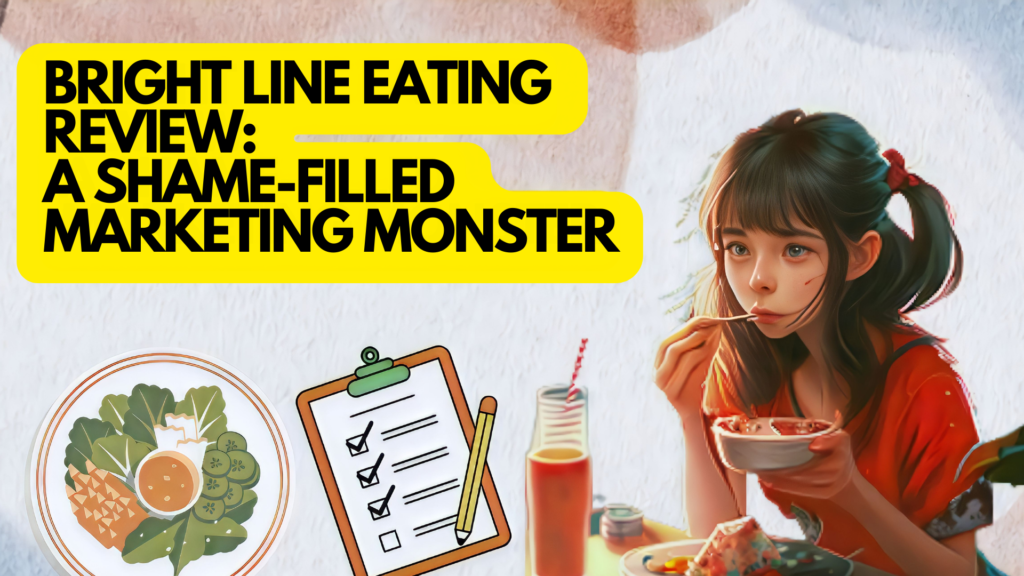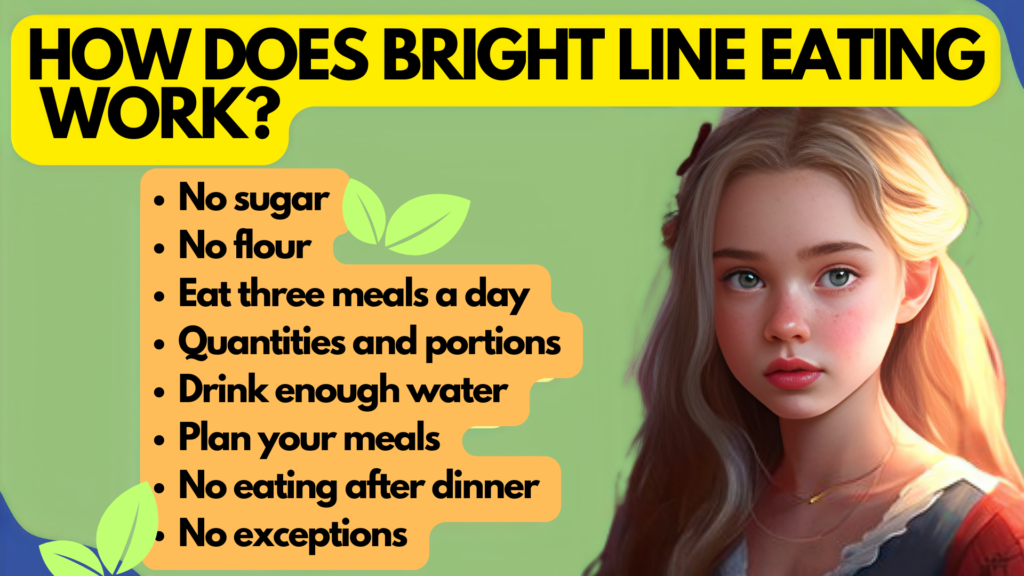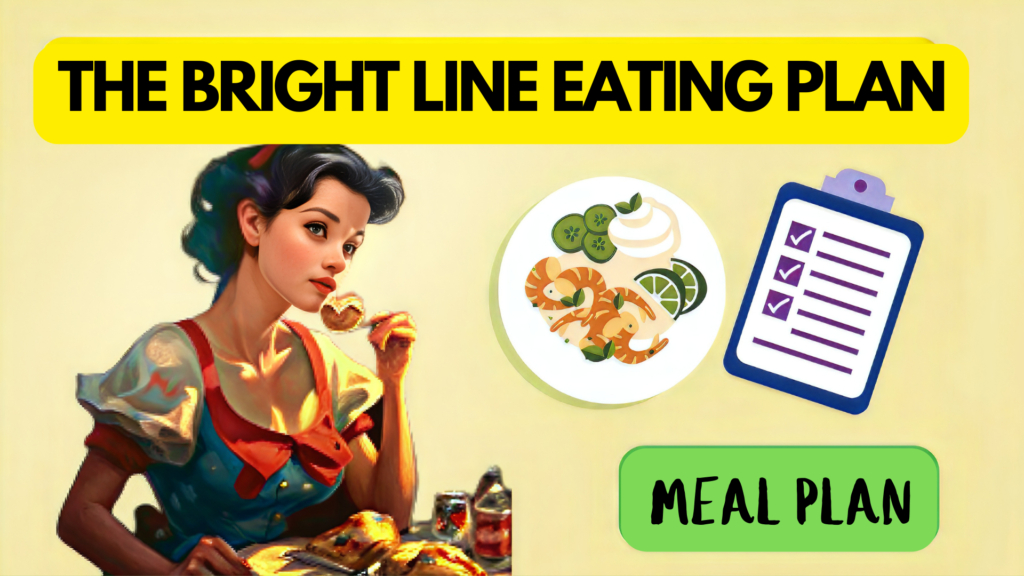Bright Line Eating is a weight loss program that has gained immense popularity in recent years. While many individuals claim to have had success with the program, it has also been surrounded by controversy. The bright line eating controversy revolves around the marketing tactics used to promote the program and the shame-filled messaging that is associated with it. This article will take a closer look at Bright Line Eating, exploring its marketing strategies and the impact they have on its users. Additionally, we will examine the potential dangers associated with the program, and consider whether or not it is a sustainable and healthy approach to weight loss.

WHAT IS BRIGHTLINE EATING?
By establishing “bright lines,” or stringent guidelines for what and when to eat, the weight reduction program Bright Line Eating makes the claim that it provides a scientific approach to weight loss. While the idea of having clear guidelines might sound appealing to some, the program’s rigid approach has sparked a lot of Bright Line Eating controversy in the nutrition community.
The main issue with Bright Line Eating is that it promotes a one-size-fits-all approach to weight loss, completely disregarding the fact that everyone’s body is different. What works for one person may not work for another, and a program that doesn’t account for these differences is unlikely to be successful in the long term.
Moreover, Bright Line Eating places a heavy emphasis on eliminating entire food groups, such as grains and dairy, which can lead to nutrient deficiencies and other health problems. The program also fails to address the psychological and emotional aspects of eating, which are crucial for sustainable weight loss.
Additionally, Bright Line Eating is not backed by any credible scientific research, and the claims made by the program’s founder, Susan Peirce Thompson, are not supported by any peer-reviewed studies. In fact, some experts in the field of nutrition have raised concerns about the program’s lack of evidence and potential for harm.
In conclusion, I cannot recommend Bright Line Eating as a safe and effective weight loss program. The Bright Line Eating controversy surrounding it is justified, and the risks associated with its rigid approach and lack of scientific evidence far outweigh any potential benefits it might offer.
HOW DOES BRIGHT LINE EATING WORK?

Bright Line Eating is based on the concept of Bright Line Eating controversy, which is the idea of strict rules and regulations around food. While this approach may work for some individuals, it is not a sustainable or healthy approach to weight loss.
The Bright Line Eating program requires individuals to adhere to strict rules around what they can and cannot eat, including avoiding all sugar and flour-based foods. While this approach may lead to weight loss in the short-term, it is not a sustainable approach to weight loss in the long-term. In fact, it can often lead to disordered eating habits and an unhealthy relationship with food.
Furthermore, the Bright Line Eating program has no scientific evidence to support its effectiveness, and its claims of rapid weight loss often have short-lived results. The program’s emphasis on strict rules and regulations around food can make it difficult for individuals to stick to the program in the long-term, leading to rebound weight gain.
The Bright Line Eating controversy, which the Bright Line Eating program is based on, has been a topic of debate in the nutrition and weight loss community. While some individuals may find success with this approach, it is important to note that it is not a one-size-fits-all solution to weight loss.
I believe that sustainable and healthy weight loss should be based on a balanced diet and regular exercise, rather than strict rules and regulations around food. I cannot recommend the Bright Line Eating program as a sustainable or healthy approach to weight loss, and I caution individuals to be wary of weight loss products that promise quick fixes or use controversial approaches like bright line eating to market their products.
THE BRIGHT LINE EATING PLAN

One product that has recently gained a lot of attention is the Bright Line Eating Plan. While this diet may seem promising at first glance, there is quite a bit of Bright Line Eating controversy surrounding it.
One of the biggest concerns with the Bright Line Eating Plan is its strict rules and rigidity. The diet promotes the idea of “bright lines,” or clear-cut rules that must be followed in order to see results. While this may work for some people, it can be incredibly difficult to maintain over the long term. The diet requires participants to completely eliminate certain foods, including sugar, flour, and processed foods. This kind of extreme restriction can be unsustainable and lead to feelings of deprivation, which can ultimately result in binge eating or other disordered eating patterns.
Another issue with the Bright Line Eating Plan is its lack of flexibility. The diet does not allow for any deviations or exceptions, which can make it challenging for individuals to maintain their social lives or stick to the diet while traveling. This can lead to feelings of isolation and frustration, which can ultimately sabotage weight loss efforts.
While the diet claims to be based on neuroscience and psychology, many experts in these fields have expressed skepticism about the validity of the research behind it. Without solid scientific evidence to support its claims, it is difficult to say whether the Bright Line Eating Plan is an effective weight loss strategy.
Overall, while the Bright Line Eating Plan may work for some individuals, it is important to approach it with caution. The rigidity and lack of flexibility of the diet can lead to feelings of deprivation and isolation, which can ultimately sabotage weight loss efforts.
There’s a lot of ‘tough love’ and hyperbole in this diet.
The BrightLine eating plan relies on the concept of “bright lines,” which are strict rules that individuals must adhere to in order to achieve desired results. The program requires participants to eliminate certain foods, including sugar, flour, and processed foods, and does not allow any exceptions or deviations from the plan. This kind of rigid approach can be incredibly challenging to maintain over the long term, and can lead to feelings of deprivation and binge eating.
Additionally, the hyperbolic promises made by the BrightLine program can be misleading and dangerous. While the program claims to be based on neuroscience and psychology, the scientific evidence behind it is not yet well-established. Furthermore, the program promotes the idea that weight loss is a simple matter of willpower and discipline, which can be harmful to those struggling with disordered eating patterns.
The Bright Line Eating controversy surrounding the BrightLine eating plan is further compounded by its lack of flexibility. The program does not allow for any exceptions, which can make it difficult for individuals to maintain their social lives or stick to the diet while traveling. This can lead to feelings of isolation and frustration, which can ultimately sabotage weight loss efforts.
I do not recommend the BrightLine eating plan as a healthy or sustainable approach to weight loss. The strict rules, hyperbole, and lack of scientific evidence behind the program raise concerns about its long-term effectiveness and safety. Instead, I recommend a more balanced and flexible approach to weight loss that emphasizes healthy eating habits and a healthy relationship with food.
Thompson also makes some interesting claims.
According to her, Brightline is “the most effective diet in the world,” but there is no evidence to support this claim. She conducts “research” on her own clients, yet she has not published a single peer-reviewed paper to back up her assertions. In fact, her own transformation story raises serious red flags – she claims to have gone from a size 4 to a size 24 in just three months before starting her diet, which is physiologically impossible.
Furthermore, Thompson’s claim that a Brightline follower with type 1 diabetes was able to come off insulin is not only impossible but also dangerous and irresponsible. It’s clear that Brightline Eating is a marketing machine, as evidenced by the multiple affiliate links in online blog reviews, and the overwhelmingly positive but suspiciously similar Amazon reviews of her book.
The Brightline website feels like one big sales pitch, and although there are free videos of Thompson speaking about her approach, accessing everything else requires payment, including boot camps, support groups, and programs to help followers “Rezoom” when they fall off the wagon. It’s a classic bait-and-switch.
Adding to the issue, controversial figures like Mark Hyman and Gary Taubes endorse this diet. When backed by such charlatans, it becomes difficult to take any diet seriously.
In conclusion, while Brightline may be similar to free programs like Food Addicts Anonymous, it is far more expensive and lacks scientific evidence to support its extreme claims. It’s important to approach any weight loss program with a critical eye and to rely on well-established science and evidence-based practices.
MY BRIGHTLINE EATING REVIEW
This diet emphasizes low calorie and low carb foods, with an emphasis on vegetables, but it may not be satisfying without a reasonable portion of other foods.
One of the concerning aspects of the Brightline Diet is that it disregards internal cues, such as hunger and cravings, and may lead to feelings of shame around food. This diet can also give the impression that individuals are addicted to food and cannot control their bodies, which is not a healthy mindset.
Another concern is that the Brightline Diet discourages exercise, which is not based on scientific evidence and can deprive individuals of the calories they need or an outlet for stress. This diet requires strict food portion control, even in social settings, which can be burdensome and even trigger disordered eating patterns.
In summary, the Brightline Diet may work for some people, but it is a punishing and shaming approach that is not recommended. Those at risk of disordered eating should avoid this diet and instead address any underlying issues that may be contributing to their relationship with food.
Quick answers to frequently asked questions:
What is the Bright line controversy in law and accounting?
The Bright line controversy refers to a debate over whether certain accounting or legal rules should use a clear and specific threshold, or “bright line,” to determine whether an action or transaction is permissible or not. Supporters of bright lines argue that they provide clarity and consistency in decision-making, while opponents argue that they can be too rigid and may not account for nuanced or situational factors. The controversy has arisen in a variety of contexts, including tax law, financial reporting, and securities regulation.






